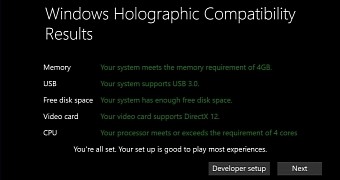Microsoft announced at its late October event that it’s working to bring Windows 10 in the VR world with Windows Holographic, a new platform that’s supposed to let devices such as HTC Vive, Oculus Rift, and other headsets enjoy the power of the new operating system.
Redmond said from the very beginning that the target was to make these headsets available for as much as $299, which is quite a small price to pay for what you get with Windows 10 in VR, but the main concern for the majority of users was the processing power that a computer would need to run the platform.
Fortunately, it turns out that Microsoft has paid particular attention to this side of Windows Holographic, and technical requirements that were published today do nothing than to confirm this.
For example, what you need is a computer with a quad-core processor, 4 GB RAM, and a USB 3.0 port, but also a graphics card that supports DirectX 12. If your system has more than this, then you’re all covered.
Hardware requirements
To make sure that Windows Holographic can be used on a specific computer, Microsoft has developed an application called “Windows Holographic First Run,” whose purpose is to scan a system and determine whether it meets the minimum hardware requirements or not (you can consider it the Get Windows 10 equivalent of the holographic push).
All you need to do is download and install this app, and then let it scan the computer. The whole process doesn’t take more than a couple of minutes, and you’re then provided with a summary to find out whether your computer can be used with VR headsets or not.
Microsoft will talk more about all of these next month in a dedicated event, and just as usual, more documentation on how everything works should reach the web through the company’s own blogs.

 14 DAY TRIAL //
14 DAY TRIAL //